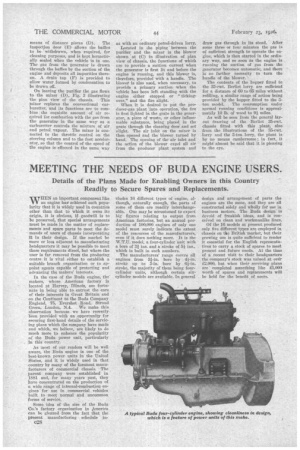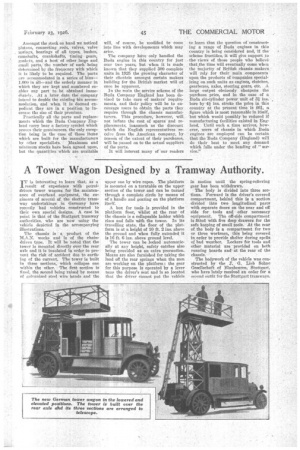MEETING THE NEEDS OF BUDA ENGINE USERS.
Page 12

Page 13

If you've noticed an error in this article please click here to report it so we can fix it.
Details of the Plans Made for Enabling Owners in this Country Readily to Secure Spares and Replacements.
WHEN an important component like an engine has achieved such popularity that it is widely used in countries other than that to which it owes its origin, it is obvious, if goodwill is to be preserved, that specisi arrangements must be made in the matter of replacements and spare parts to meet the demands of users of chassis incorporating it in their design. If the market be more or less adjacent to manufacturing headquarters it may be possible to meet these requirements direct, but where the user is far removed from the producing centre it is vital either to establish a suitable branch organization or to appoint agents capable of protecting and advancing the makers' interests.
In the ease of the Buda engine, the makers, whose American factory is located at Harvey, • Illinois, are fortunate in being able to .entrust the care of their interests in Great Britain and on the Continent to the Buda Company England, 75, Evershot Road, Stroud Green, London, N.4. We make •this observation because . we have recently been provided with an opportunity for securing first-hand details of the servicing plans which the company have made and which, we believe, are likely to do much more to enhance the popularity or the Buda power unit, particularly in this country.
As :nest of our readers will be well aware, the Buda engine is one of the best-known power units in the United States, and it is widely used in that country by many of the foremost manufacturers of commercial chassis. The parent company were established in 1881 and, for many years past, they have concentrated on the production of a wide range of internal-combustion engines for use in commercial vehicles built to meet normal and uncommon forms of service.
Some idea of the size of the Buda Co.'s factory organization in AtnerWa can be gleaned from the fact that the present manufacturing schedule in c28
-cludes 16 different types of engine, although, naturally enough, the parts of some of them are readily interchangeable. One may he accustomed to expeetbig figures relating to output from American factories, but an annual production of 100,000 engines of only one model must surely indicate the extent of the resources of the manufacturers, even if it does nothing more. It is the W.T.U. model, a four-cylinder unit with a tore of Z.`i ins. and a stroke of 5-ir ins., which is built in such numbers.
The manufacturers' range covers all engines from 31-in. bore by 4k-in. stroke up to 5-in, bore by stroke, the majority of them being fourcylinder units, although certain sixcylinder models are available. In general
design and arrangement of parts the engines are the same, and they are all constructed solely and wholly for use in business motors. The Buda design--is devoid of freakish ideas, and is conceived on clean and workmanlike lines.
Of the 16 models at present produced only five different types are employed in chassis on the British .market, but their growing use is quite sufficient to render it essential for the English representativee to carry a stock of spares to meet present and future needs. At the time of a recent visit to their headquarters the company's stock was valued at ovdr £2.000, but when their servicing plans are. completed something like 15,000 worth of spares and replacements will be held for the benefit of users. Amongst the stock on hand we noticed -pistons, connecting .rods', valves, valve springs, bearings of all types, bushes, camshafts, crankshafts, timing gears, gaskets, and a host of other large and small parts, 'the number of each being determined by the frequency with which it is likely to be required. The parts are accommodated in a series of bins1,000 in all--and the orderly manner in which they are kept and numbered enables any part to be obtained immediately. At a later. date the company intend to double the 'existing bin accommodation, and when it is deemed expedient they are in a position to inCrease the size of their premises.
Practically all the parts and replacements which the Buda Company England carry bear a factory symbol which proves their genuineness, the only exception being in the ease of those items which are builtfor the manufacturers by other specialists. Maximum and minimum stocks have been agreed upon, but the quantities which are available will, of course, be modified to come into line With developments which may arise.
The company have only handled the Buda engine in this country for just over two years, but when it is made, known that they supplied 300 complete units in 1925 the growing character of their clientele amongst certain makera building flu. the British market will at once be apparent.
In the main the service scheme of the Buda Company England has been devised to take care of makers' requirements, and their policy will be to encourage users to obtain the parts they require through the chassis manufacturers. This procedure, however, will not inflate the cost of spares and replacements, inasmuch as the discount which the English yepresentatives. reeeive, from the American company, by reason of the extent of their purchases, will be passed on to the actual suppliers of the parts.
It will 'littereEt many of 'our readers
to learn that the question of constructing a range of Buda engines in this Country is being considered and, if the scheme fructifies, it will give support to the views of thoSe people who believe that.the time will eventually come when the majority of British chassis makers will rely for their main components upon the products of companies specializing on such units as engines, clutches, gearboxes, axles, steering gears, etc. A large output obviously cheapens the purchase price, and in the case of a Buda six-cylinder power unit of n ins. bore by ft ins, stroke the price in this country at the present time is R31, a figure which is most reasonable in itself, but which would possibly be reduced if manufacturing facilities existed in England. Until such a time arrives, however, users of chassis in which Buda engines are employed can be certain that the Buda Company (England) will do their best to meet any demand which falls under the heading of " service."






























